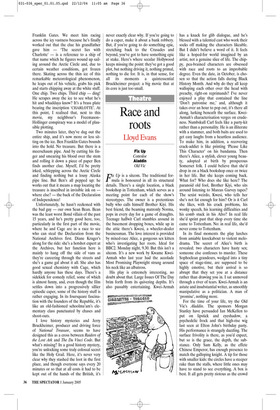History mystery
Mark Steyn
National Treasure 12A, selected cinemas Ialways like it when some fellow has a kid late in life and two centuries later you wind up talking to some l’il ol’ lady whose gram’pa was in the War of 1812 — the long slender thread of a personal connection to history. That’s how National Treasure begins: it’s 1974 and Christopher Plummer is talking to his wee grandson about a tale he in turn heard as a young slip of a lad from his own grandfather, who in turn heard it from the last surviving signer of the Declaration of Independence. It’s about hidden treasure — but not some rinky-dink nouveau-riche arriviste 18thcentury treasure. No, this goes way back: men have fought over it for generations and, just to prove it, while Christopher Plummer’s yakking on, director Jon Turteltaub cuts to some Roman guys in leather skirts warring over unspecified artefacts. It goes way back before that, of course, but wisely Turteltaub decided not to show Ug the Caveman trying to swipe it out from under the triceratops next door. The Knights Templar found it, and brought it to Europe and, after they’d evolved into the Freemasons, they decided it was too much for any one king and so brought it to America.
Any conspiracy-minded Internet wallah will already be enjoying a delicious frisson just from the Knights Templar and Freemason namechecks. My neighbour gets up at four every morning and spends the first 90 minutes of his day on his computer accumulating yet more proof that the Knights Templar were an embryo secret world government that led directly to the Freemasons and thence to the Trilateral Commission and the Carlyle Group. In a further twist, he ‘uncovered’ ‘evidence’ last year that the real heirs to the inner circle of Knights Templar are the board of Hollinger International (the Speccie’s former owners). I said casually, ‘Oh, really? I work for Hollinger,’ since when he’s been very wary of me and can’t quite understand why I haven’t had him killed yet.
So anything involving Knights Templar and hidden secrets ought to be a surefire smash. But then the title flashes up, it’s 30 years later and the cute little grandson is now Nicolas Cage, playing one Benjamin Franklin Gates. We meet him racing across the icy vastness because he’s finally worked out that the clue his grandfather gave him — ‘The secret lies with Charlotte’ — is a reference to a ship of that name which he figures wound up sailing around the Arctic Circle and, due to certain weather conditions, got frozen there. Skating across the thin ice of this remarkable meteorological phenomenon, he leaps out of his vehicle, grabs his pick and starts chipping away at the white stuff. One chip. Two chips. Third chip — ding! He scrapes away the ice to see what he’s hit and whaddaya know? It’s a brass plate bearing the inscription ‘CHARLOTTE’. At this point, I realised that, next to this movie, my neighbour’s FreemasonHollinger conspiracy was a model of plausible plotting.
Two minutes later, they’ve dug out the entire ship, and it’s now more or less sitting on the ice. Ben Franklin Gates bounds into the hold. No treasure. But there is a meerschaum pipe. And by cutting his finger and smearing his blood over the stem and rolling it down a piece of paper Ben finds another clue. Myself, I’d be pretty irked, schlepping across the Arctic Circle and finding nothing but a lousy Alaska pipe line. But Ben’s all pepped up: he works out that it means a map locating the treasure is inscribed in invisible ink on where else? — the back of the Declaration of Independence!
Unfortunately, he hasn’t reckoned with the bad guy — our own Sean Bean. Bean was the least worst Bond villain of the past 15 years, and he’s pretty good here, too, particularly in the first part of the movie, where he and Cage are in a race to see who can steal the Declaration from the National Archives first. Diane Kruger’s along for the ride: she’s a hotshot expert at the Archives, but her function here is mainly to hang off the side of vans as they’re careering through the streets and she’s a game gal about it all. She also has good sexual chemistry with Cage, which hardly anyone has these days. There’s a sidekick for comedy relief, some of which is almost funny, and, even though the film settles down into a progressively sillier episodic caper, some of the history stuff is rather engaging. In its foursquare fascination with the founders of the Republic, it’s like an old-fashioned schoolma’am’s elementary class punctuated by chases and shoot-outs.
I love history mysteries and Jerry Bruckheimer, producer and driving force of National Treasure, seems to have designed this as a cross between Raiders of the Lost Ark and The Da Vinci Code. But what’s missing? In a good history mystery, you’re unlocking some truly colossal secret like the Holy Grail. Here, it’s never very clear why they stashed the loot in the first place, and though everyone says every 20 minutes or so that at all costs it had to be kept out of the hands of the British, it’s never exactly clear why. If you’re going to do a caper, make it about a bank robbery. But, if you’re going to do something epic, stretching back to the Crusades and beyond, you’ve got to have something epic at stake. Here’s where secular Hollywood keeps missing the point: they’ve got a good plot, but nothing driving it, nothing primal, nothing to die for. It is, in that sense, for all its moments a quintessential Bruckheimer project: a big movie that at its core is just too small.








































 Previous page
Previous page